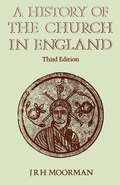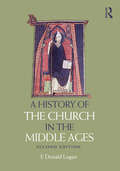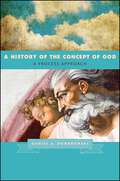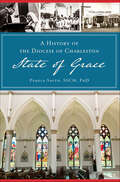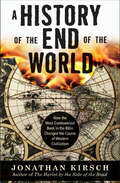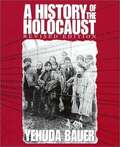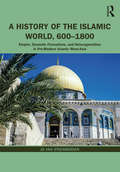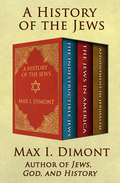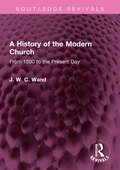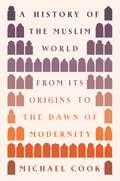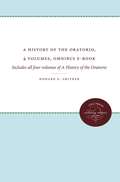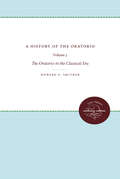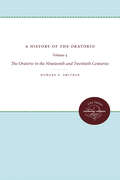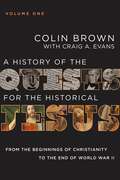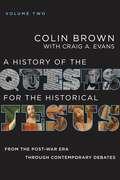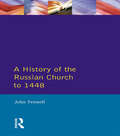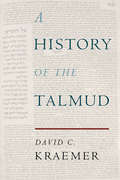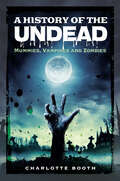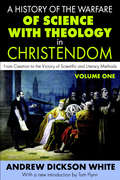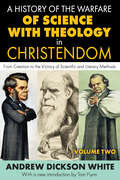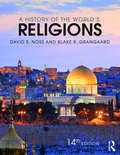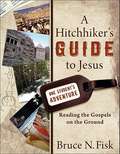- Table View
- List View
A History of the Church in England (3rd Edition)
by J R MoormanA lively account of Christianity in Britain, from the Roman and Celtic eras up through the Reformation and the modern church. This authoritative account of the Church in England covers its history from earliest times to the late twentieth century—including chapters on the Roman, Celtic, Anglo-Saxon, Norman, and Medieval periods before a description of the Reformation and its effects, the Stuart period, and the Industrial Age, with a final chapter on the modern church through 1972. After shedding light on how the faith spread during ancient times with historical tales of conversion and persecution, and revealing the details behind figures like St. Patrick, his interactions with pagan Irish tribes, and the monasteries he founded, the book goes on to cover the conversion of England, including the legendary stories of St. Gregory the Great and the Anglian boys and Augustine’s baptism of over ten thousand people in the area of Canterbury on a single Christmas Day. Moving on through the centuries, it tells of scholars like Aldhelm, Bede, and Alcuin; Viking invasions; kings, popes, and power struggles; and the translation of the Bible. It conveys the impact of world-changing individuals like Henry VIII and Martin Luther and the breach with Rome; then moving toward the modern period tells of the evolution of the Church of England, the early Evangelicals, and the social and cultural changes of the twentieth century. With fascinating detail on the church’s role in everything from art and architecture to education, this is a wide-ranging look at British history through the perspective of religion.
A History of the Church in the Middle Ages
by F Donald Logan"Conceptually well organized, stylistically clear, intellectually thoughtful, and pedagogically useful." - Thomas Head, Speculum "For its humane and learned approach to its enormous canvas, as well as for the cogency with which it penetrates at speed to the essentials of a vanished historical epoch, this History of the Church in the Middle Ages deserves a very wide audience indeed." - Barrie Dobson, English Historical Review "To have written a scholarly and very readable history of the Western Church over a millennium is a remarkable tour de force, for which Donald Logan is to be warmly congratulated." - C.H Lawrence, The Tablet "A feat of historical synthesis, most confident in its telling of the coming of Christianity. Books like Logan's are needed more than ever before." - Miri Rubin, TLS In this fascinating survey, F. Donald Logan introduces the reader to the Christian church, from the conversion of the Celtic and Germanic peoples to the discovery of the New World. He reveals how the church unified the people of Western Europe as they worshipped with the same ceremonies and used Latin as the language of civilized communication. From remote, rural parish to magnificent urban cathedral, A History of the Church in the Middle Ages explores the role of the church as a central element in determining a thousand years of history. This new edition brings the book right up to date with recent scholarship, and includes an expanded introduction exploring the interaction of other faiths - particularly Judaism and Islam - with the Christian church.
A History of the Concept of God: A Process Approach
by Daniel A. DombrowskiDaniel A. Dombrowski explores the history of the concept of God from the perspective of neoclassical, or process, theism. His neoclassical approach assuages the current crisis in philosophical theism, caught between a defense of classical theism and assertions of religious skepticism. Instead, the work offers Charles Hartshorne's notion of a God who always evolves, quite unlike the allegedly perfect figure of more traditional, and increasingly unsatisfactory, accounts. Dombrowski surveys the classical theists and their roots in ancient Greek philosophy before turning to contributions from the sixteenth through twentieth centuries, ultimately discussing twenty-three thinkers. The key figures in this history are Plato, who ironically provided the philosophical basis both for classical and neoclassical concepts, and three great figures in process theism: Henri Bergson, Alfred North Whitehead, and Hartshorne. The concept of God has a rich past; this book argues that it can have a rich future as well.
A History of the Diocese of Charleston: State of Grace
by Pamela SmithIn 1820, the Catholic Diocese of Charleston was established, and Bishop John England arrived from Ireland. His new diocese encompassed North and South Carolina, Georgia and, for a time, Haiti. From 1859 to 1885, when Patrick Lynch and Henry Northrop were bishops of Charleston, the diocese included the Bahama Islands. However, the history of Catholics in the diocese--which now covers all of South Carolina--began much earlier. The arrival of Spanish settlers and missionary priests dated back more than 150 years before there was a diocese on American soil. Sister Pam Smith charts the history of the diocese from the first words of prayer uttered on Santa Elena in the sixteenth century through the interfaith singing of a reformed slaveholder's hymn at a painful funeral in the twenty-first century.
A History of the End of the World: How the Most Controversial Book in the Bible Changed the Course of Western Civilization
by Jonathan Kirsch"[The Book of] Revelation has served as a "language arsenal" in a great many of the social, cultural, and political conflicts in Western history. Again and again, Revelation has stirred some dangerous men and women to act out their own private apocalypses. Above all, the moral calculus of Revelation—the demonization of one's enemies, the sanctification of revenge taking, and the notion that history must end in catastrophe—can be detected in some of the worst atrocities and excesses of every age, including our own. For all of these reasons, the rest of us ignore the book of Revelation only at our impoverishment and, more to the point, at our own peril."The mysterious author of the Book of Revelation (or the Apocalypse, as the last book of the New Testament is also known) never considered that his sermon on the impending end times would last beyond his own life. In fact, he predicted that the destruction of the earth would be witnessed by his contemporaries. Yet Revelation not only outlived its creator; this vivid and violent revenge fantasy has played a significant role in the march of Western civilization. Ever since Revelation was first preached as the revealed word of Jesus Christ, it has haunted and inspired hearers and readers alike. The mark of the beast, the Antichrist, 666, the Whore of Babylon, Armageddon, and the Four Horsemen of the Apocalypse are just a few of the images, phrases, and codes that have burned their way into the fabric of our culture. The questions raised go straight to the heart of the human fear of death and obsession with the afterlife. Will we, individually or collectively, ride off to glory, or will we drown in hellfire for all eternity? As those who best manipulate this dark vision learned, which side we fall on is often a matter of life or death. Honed into a weapon in the ongoing culture wars between states, religions, and citizenry, Revelation has significantly altered the course of history. Kirsch, whom the Washington Post calls "a fine storyteller with a flair for rendering ancient tales relevant and appealing to modern audiences," delivers a far-ranging, entertaining, and shocking history of this scandalous book, which was nearly cut from the New Testament. From the fall of the Roman Empire to the Black Death, the Inquisition to the Protestant Reformation, the New World to the rise of the Religious Right, this chronicle of the use and abuse of the Book of Revelation tells the tale of the unfolding of history and the hopes, fears, dreams, and nightmares of all humanity.
A History of the Holocaust (Revised Edition)
by Yehuda Bauer Nili KerenThe author traces the roots of anti-Semitism that burgeoned through the ages and provides a comprehensive description of how and why the Holocaust occurred.
A History of the Islamic World, 600-1800: Empire, Dynastic Formations, and Heterogeneities in Pre-Modern Islamic West-Asia
by Jo Van SteenbergenA History of the Islamic World, 600–1800 supplies a fresh and unique survey of the formation of the Islamic world and the key developments that characterize this broad region’s history from late antiquity up to the beginning of the modern era. Containing two chronological parts and fourteen chapters, this impressive overview explains how different tides in Islamic history washed ashore diverse sets of leadership groups, multiple practices of power and authority, and dynamic imperial and dynastic discourses in a theocratic age. A text that transcends many of today’s popular stereotypes of the premodern Islamic past, the volume takes a holistically and theoretically informed approach for understanding, interpreting, and teaching premodern history of Islamic West-Asia. Jo Van Steenbergen identifies the Asian connectedness of the sociocultural landscapes between the Nile in the southwest to the Bosporus in the northwest, and the Oxus (Amu Darya) and Jaxartes (Syr Darya) in the northeast to the Indus in the southeast. This abundantly illustrated book also offers maps and dynastic tables, enabling students to gain an informed understanding of this broad region of the world. This book is an essential text for undergraduate classes on Islamic History, Medieval and Early Modern History, Middle East Studies, and Religious History.
A History of the Jewish People
by H. H. Ben-SassonThis textbook provides an overview of Jewish history beginning in ancient times, and Bible students will find these parts of this book to be an extremely useful reference. The book features pieces by several dozen authors, each with a unique perspective and expertise in the historical time being presented.
A History of the Jews: The Indestructible Jews, The Jews in America, and Appointment in Jerusalem
by Max I. DimontThree books on Jewish heritage from the author of Jews, God, and History, &“the best popular history of the Jews written in the English language&” (Los Angeles Times). With over a million and a half copies sold, Jews, God and History introduced readers to &“the fascinating reasoning&” of acclaimed scholar Max I. Dimont&’s &“bright and unorthodox mind&” (San Francisco Sunday Examiner and Chronicle). In these three volumes, Dimont builds on the themes and insights presented in that seminal work, providing a rich and comprehensive portrait of the cultural and religious history of the Jewish people. The Indestructible Jews traces the four-thousand-year journey of the Jewish people from an ancient tribe with a simple faith to a global religion with adherents in every nation. Through countless expulsions and migrations, the great tragedy of the Holocaust and the joy of founding a homeland in Israel, this compelling history evokes a proud heritage while offering a hopeful vision of the future. The Jews in America offers an overview of Judaism in the United States from colonial times to twentieth-century Zionism. Dimont follows the various waves of immigration, recounts the cultural achievements of those who escaped oppression in their native lands, and discusses the attitudes of American Jews—both religious and secular—toward Israel. Appointment in Jerusalem explores the mystery surrounding the predictions Jesus made about his fate. Dimont re-creates the drama in three acts using his knowledge of the events recorded in the Bible. Thoughtful and fascinating, his account offers fresh insights into questions that have surrounded religion for centuries. Who was Jesus—the Christian messiah or a member of a Jewish sect?
A History of the Modern Church: From 1500 to the Present Day (Routledge Revivals)
by J. W. WandFirst published in 1930, A History of the Modern Church is a scholarly and readable account of the church from the beginning of the Reformation to modern times. It traces the rise of many attitudes towards life, many conceptions of the faith, and many ecclesiastical systems. This book will be of interest to students of religion and history.
A History of the Muslim World: From Its Origins to the Dawn of Modernity
by Michael A. CookA panoramic history of the Muslim world from the age of the Prophet Muḥammad to the birth of the modern eraThis book describes and explains the major events, personalities, conflicts, and convergences that have shaped the history of the Muslim world. The body of the book takes readers from the origins of Islam to the eve of the nineteenth century, and an epilogue continues the story to the present day. Michael Cook thus provides a broad history of a civilization remarkable for both its unity and diversity.After setting the scene in the Middle East of late antiquity, the book depicts the rise of Islam as one of the great black swan events of history. It continues with the spectacular rise of the Caliphate, an empire that by the time it broke up had nurtured the formation of a new civilization. It then goes on to cover the diverse histories of all the major regions of the Muslim world, providing a wide-ranging account of the key military, political, and cultural developments that accompanied the eastward and westward spread of Islam from the Middle East to the shores of the Atlantic and the Pacific.At the same time, A History of the Muslim World contains numerous primary-source quotations that expose the reader to a variety of acutely insightful voices from the Muslim past.
A History of the Oratorio, 4 volumes, Omnibus E-book
by Howard E. SmitherThe University of North Carolina Press is proud to announce Howard Smither's ground-breaking four-volume A History of the Oratorio, are now available in one convenient Omnibus E-Book edition. Published as UNC Press Enduring Editions, these volumes bring Smither's landmark scholarship to a new generation of readers and scholars.Written by an eminent scholar in a style that represents American musicological writing at its communicative best, A History of the Oratorio offers a synthesis and critical appraisal so exhaustive and reliable that the serious student of the oratorio will be compelled to look to these volumes as an indispensable source. No work on the history of the oratorio has yet appeared in the English language that is comparable in scope and treatment with Smither's comprehensive four-volume work.Volumes 1 and 2, published by the University of North Carolina Press in 1977, treated the oratorio in the Baroque era, while Volume 3, published in 1987, explored the genre in the Classical era. The final volume, Volume 4, published in 2000, surveys the history of nineteenth- and twentieth-century oratorio, stressing the main geographic areas of oratorio composition and performance: Germany, Britain, America, and France.A History of the Oratorio is the first full-length history of the genre since Arnold Schering published his Geschichte des Oratoriums in 1911. In addition to synthesizing current thought about the oratorio, these volumes contribute new information on relationships between oratorio librettos and contemporary literary and religious thought, and on the musical differences among oratorios from different geographical-cultural regions.Information on the 4 volumes included in this Omnibus E-Book:A HISTORY OF THE ORATORIOHoward E. SmitherVolume 1: The Oratorio in the Baroque Era: Italy, Vienna, Paris507 pp., 59 illus., 74 music examplesVolume 2: the Oratorio in the Baroque Era: Protestant Germany and England415 pp., 48 illus., 75 music examplesVolume 3: the Oratorio in the Classical Era736 pp., 37 illus., 30 tables, 110 music examplesVolume 4: The Oratorio in the Nineteenth and Twentieth Centuries856 pp., 24 illus., 33 tables, 90 figs.About UNC Press Enduring Editions UNC Press Enduring Editions use the latest in digital technology to make available again books from our distinguished backlist that were previously out of print. These editions are published unaltered from the original, and are presented in affordable paperback formats, bringing readers both historical and cultural value.
A History of the Oratorio: Vol. 3: the Oratorio in the Classical Era
by Howard E. SmitherThe Oratorio in the classical Era is the third volume of Howard Smither's monumental History of the Oratorio, continuing his synthesis and critical appraisal of the oratorio. His comprehensive study surpasses in scope and treatment all previous works on the subject. A fourth and final volume, on the oratorio in the nineteenth and twentieth centuries, is forthcoming.In this volume Smither discusses the Italian oratorio from the 1720s to the early nineteenth century and oratorios from other parts of Europe from the 1750s to the nineteenth century. Drawing on works that represent various types, languages, and geographical areas, Smither treats the general characteristics of oratorio libretto and music and analyzes twenty-two oratorios from Italy, England, Germany, France, and Russia. He synthesizes the results of specialized studies and contributes new material based on firsthand study of eighteenth-century music manuscripts and printed librettos. Emphasizing the large number of social contexts within which oratorios were heard, Smither discussed examples in Italy such as the Congregation of the Oratory, lay contrafraternities, and educational institutions. He examines oratorio performances in German courts, London theaters and English provincial festivals, and the Parisian Concert spirituel. Though the volume concentrates primarily on eighteenth-century oratorio from the early to the late Classical styles, Smither includes such transitional works as the oratorios of Jean-Francios le Seur in Paris and Stepan Anikievich Degtiarev in Moscow.A History of the Oratorio is the first full-length history of the genre since Arnold Schering's 1911 study. In addition to synthesizing current thought about the oratorio, this volume contributes new information on relationships between oratorio librettos and contemporary literary and religious thought, and on the musical differences among oratorios from different geographical-cultural regions.Originally published in 1987.A UNC Press Enduring Edition -- UNC Press Enduring Editions use the latest in digital technology to make available again books from our distinguished backlist that were previously out of print. These editions are published unaltered from the original, and are presented in affordable paperback formats, bringing readers both historical and cultural value.
A History of the Oratorio: Vol. 4: The Oratorio in the Nineteenth and Twentieth Centuries
by Howard E. SmitherWith this volume, Howard Smither completes his monumental History of the Oratorio. Volumes 1 and 2, published by the University of North Carolina Press in 1977, treated the oratorio in the Baroque era, while Volume 3, published in 1987, explored the genre in the Classical era. Here, Smither surveys the history of nineteenth- and twentieth-century oratorio, stressing the main geographic areas of oratorio composition and performance: Germany, Britain, America, and France.Continuing the approach of the previous volumes, Smither treats the oratorio in each language and geographical area by first exploring the cultural and social contexts of oratorio. He then addresses aesthetic theory and criticism, treats libretto and music in general, and offers detailed analyses of the librettos and music of specific oratorios (thirty-one in all) that are of special importance to the history of the genre.As a synthesis of specialized literature as well as an investigation of primary sources, this work will serve as both a springboard for further research and an essential reference for choral conductors, soloists, choral singers, and others interested in the history of the oratorio.Originally published 2000.A UNC Press Enduring Edition -- UNC Press Enduring Editions use the latest in digital technology to make available again books from our distinguished backlist that were previously out of print. These editions are published unaltered from the original, and are presented in affordable paperback formats, bringing readers both historical and cultural value.
A History of the Quests for the Historical Jesus, Volume 1: From the Beginnings of Christianity to the End of World War II
by Colin Brown Craig A. EvansA comprehensive, two-volume reassessment of the quests for the historical Jesus that details their origins and underlying presuppositions as well as their ongoing influence on today's biblical and theological scholarship.Jesus' life and teaching is important to every question we ask about what we believe and why we believe it. And yet there has never been common agreement about his identity, intentions, or teachings—even among first-century historians and scholars. Throughout history, different religious and philosophical traditions have attempted to claim Jesus and paint him in the cultural narratives of their heritage, creating a labyrinth of conflicting ideas.From the evolution of orthodoxy and quests before Albert Schweitzer's famous "Old Quest," to today's ongoing questions about criteria, methods, and sources, A History of the Quests for the Historical Jesus not only chronicles the developments but lays the groundwork for the way forward.The late Colin Brown brings his scholarly prowess in both theology and biblical studies to bear on the subject, assessing not only the historical and exegetical nuts and bolts of the debate about Jesus of Nazareth but also its philosophical, sociological, and theological underpinnings. Instead of seeking a bedrock of "facts," Brown stresses the role of hermeneutics in formulating questions and seeking answers.Colin Brown was almost finished with the manuscript at the time of his passing in 2019. Brought to its final form by Craig A. Evans, this book promises to become the definitive history and assessment of the quests for the historical Jesus.Volume One covers the period from the beginnings of Christianity to the end of World War II.Volume Two (sold separately) covers the period from the post-War era through contemporary debates.
A History of the Quests for the Historical Jesus, Volume 2: From the Post-War Era through Contemporary Debates
by Colin Brown Craig A. EvansA comprehensive, two-volume reassessment of the quests for the historical Jesus that details their origins and underlying presuppositions as well as their ongoing influence on today's biblical and theological scholarship.Jesus' life and teaching is important to every question we ask about what we believe and why we believe it. And yet there has never been common agreement about his identity, intentions, or teachings—even among first-century historians and scholars. Throughout history, different religious and philosophical traditions have attempted to claim Jesus and paint him in the cultural narratives of their heritage, creating a labyrinth of conflicting ideas.From the evolution of orthodoxy and quests before Albert Schweitzer's famous "Old Quest," to today's ongoing questions about criteria, methods, and sources, A History of the Quests for the Historical Jesus not only chronicles the developments but lays the groundwork for the way forward.The late Colin Brown brings his scholarly prowess in both theology and biblical studies to bear on the subject, assessing not only the historical and exegetical nuts and bolts of the debate about Jesus of Nazareth but also its philosophical, sociological, and theological underpinnings. Instead of seeking a bedrock of "facts," Brown stresses the role of hermeneutics in formulating questions and seeking answers.Colin Brown was almost finished with the manuscript at the time of his passing in 2019. Brought to its final form by Craig A. Evans, this book promises to become the definitive history and assessment of the quests for the historical Jesus.Volume One (sold separately) covers the period from the beginnings of Christianity to the end of World War II.Volume Two covers the period from the post-War era through contemporary debates.
A History of the Russian Church to 1488
by John L. FennellThe Russian church is central to an understanding of early Russian and Slav history, but for many years there has been no accessible, up-to-date introduction to the subject in English - until now. The late John Fennell's last book, is a masterly survey of the development, nature and role of the early Church in Russia from Christianization of the country in 988, through Kievan and Tatar poeriods to 1448 when the Russian Church finally became totally independent of its mother-church in Byzantium.
A History of the Talmud
by David C. KraemerIt is impossible to exaggerate the importance of the Talmud in Judaism and beyond. Yet its difficult language and its assumptions, so distant from modern sensibilities, render it inaccessible to most readers. In this volume, David C. Kraemer offers students of Judaism a sophisticated and accessible introduction to one of the religion's most important texts. Here, he brings together his expertise as a scholar of the Talmud and rabbinic Judaism with the lessons of his experience as director of one of the largest collections of rare Judaica in the world. Tracing the Talmud's origins and its often controversial status through history, he bases his work on the most recent historical and literary scholarship while making no assumptions concerning the reader's prior knowledge. Kraemer also examines the continuities and shifts of the Talmud over time and space. His work will provide scholars and students with an unprecedented understanding of one of the world's great classics and the spirit that animates it.
A History of the Undead: Mummies, Vampires and Zombies
by Charlotte BoothA history of Western culture’s fascination with undead creatures in film and television.Are you a fan of the undead? Watch lots of mummy, zombie and vampire movies and TV shows? Have you ever wondered if they could be “real?”This book, A History of the Undead, unravels the truth behind these popular reanimated corpses.Starting with the common representations in Western media through the decades, we go back in time to find the origins of the myths. Using a combination of folklore, religion and archaeological studies we find out the reality behind the walking dead. You may be surprised at what you find . . .
A History of the Undead: Mummies, Vampires and Zombies
by Charlotte BoothA history of Western culture’s fascination with undead creatures in film and television.Are you a fan of the undead? Watch lots of mummy, zombie and vampire movies and TV shows? Have you ever wondered if they could be “real?”This book, A History of the Undead, unravels the truth behind these popular reanimated corpses.Starting with the common representations in Western media through the decades, we go back in time to find the origins of the myths. Using a combination of folklore, religion and archaeological studies we find out the reality behind the walking dead. You may be surprised at what you find . . .
A History of the Warfare of Science with Theology in Christendom: Volume 1, From Creation to the Victory of Scientific and Literary Methods
by Andrew WhiteGiven the powerful and forthright title of Andrew Dickson White's classic study, it is best to make clear his own sense of the whole as given in the original 1896 edition: "My conviction is that science, though it has evidently conquered dogmatic theology based on biblical texts and ancient modes of thought, will go hand in hand with religion, and that although theological control will continue to diminish, religion as seen in the recognition of a 'power in the universe, not ourselves, which makes for righteousness' and in the love of God and of our neighbor, will steadily grow stronger and stronger, not only in the American institutions of learning, but in the world at large." White began to assemble his magnum opus, a two volume work first published in 1896 as A History of the Warfare of Science with Theology in Christendom. In correspondence he wrote that he intended the work to stake out a position between such religious orthodoxy as John Henry Newman's on one side and such secular scoffing as Robert Ingersoll's on the other. Historian Paul Carter declared that this book did as much as any other published work "toward routing orthodoxy in the name of science." Insofar as science and religion came to be widely viewed as enemies, with science holding the moral high ground, White inadvertently, became one of the most effective and influential advocates for unbelief.
A History of the Warfare of Science with Theology in Christendom: Volume 2, From Creation to the Victory of Scientific and Literary Methods
by J.M. CohenGiven the powerful and forthright title of Andrew Dickson White's classic study, it is best to make clear his own sense of the whole as given in the original 1896 edition: "My conviction is that science, though it has evidently conquered dogmatic theology based on biblical texts and ancient modes of thought, will go hand in hand with religion, and that although theological control will continue to diminish, religion as seen in the recognition of a 'power in the universe, not ourselves, which makes for righteousness' and in the love of God and of our neighbor, will steadily grow stronger and stronger, not only in the American institutions of learning, but in the world at large." White began to assemble his magnum opus, a two volume work first published in 1896 as A History of the Warfare of Science with Theology in Christendom. In correspondence he wrote that he intended the work to stake out a position between such religious orthodoxy as John Henry Newman's on one side and such secular scoffing as Robert Ingersoll's on the other. Historian Paul Carter declared that this book did as much as any other published work "toward routing orthodoxy in the name of science." Insofar as science and religion came to be widely viewed as enemies, with science holding the moral high ground, White inadvertently, became one of the most effective and influential advocates for unbelief.
A History of the World's Religions
by Blake Grangaard David S. NossA History of the World's Religions bridges the interval between the founding of religions and their present state, and gives students an accurate look at the religions of the world by including descriptive and interpretive details from the original source materials. Refined by over forty years of dialogue and correspondence with religious experts and practitioners around the world, A History of the World's Religions is widely regarded as the hallmark of scholarship, fairness, and accuracy in its field. It is also the most thorough yet manageable history of world religion available in a single volume, treating many subjects largely neglected in other texts.
A History of the World's Religions
by David S. Noss Blake R. GrangaardA History of the World's Religions bridges the interval between the founding of religions and their present state, and gives students an accurate look at the religions of the world by including descriptive and interpretive details from original source materials. Refined by over forty years of dialogue and correspondence with religious experts and practitioners around the world, A History of the World's Religions is widely regarded as the hallmark of scholarship, fairness, and accuracy in its field. It is also the most thorough yet manageable history of world religion available in a single volume. A History of the World’s Religions examines the following topics: Some Primal and Bygone Religions The Religions of South Asia The Religions of East Asia The Religions of the Middle East This fourteenth edition is fully updated throughout with new images and inset text boxes to help guide students and instructors. Complete with figures, timelines and maps, this is an ideal resource for anyone wanting an accessible and comprehensive introduction to the world’s religions.
A Hitchhiker's Guide To Jesus: Reading The Gospels On The Ground
by Bruce FiskThis imaginative approach to Jesus studies chronicles the journey of Norm, a fictional college graduate who travels to the Middle East to see if he can study Jesus and follow him at the same time, and if curiosity will make him a better disciple or no disciple at all. <P><P> Norm sets out on an adventure to investigate the New Testament and the life of Jesus for himself, hitchhiking simultaneously across the Gospels and the land. His travels offer students and lay readers a creative and engaging way to explore many of the major questions in Jesus studies today. Will Norm be able to reconcile his Christian faith with critical scholarship? <P><P>As readers follow his faith journey, they learn the importance of asking probing questions. The book's lavish, journal-style interior design--featuring maps, photos, doodles, sketches, and email exchanges between Norm and his professor--makes it fun to read.
